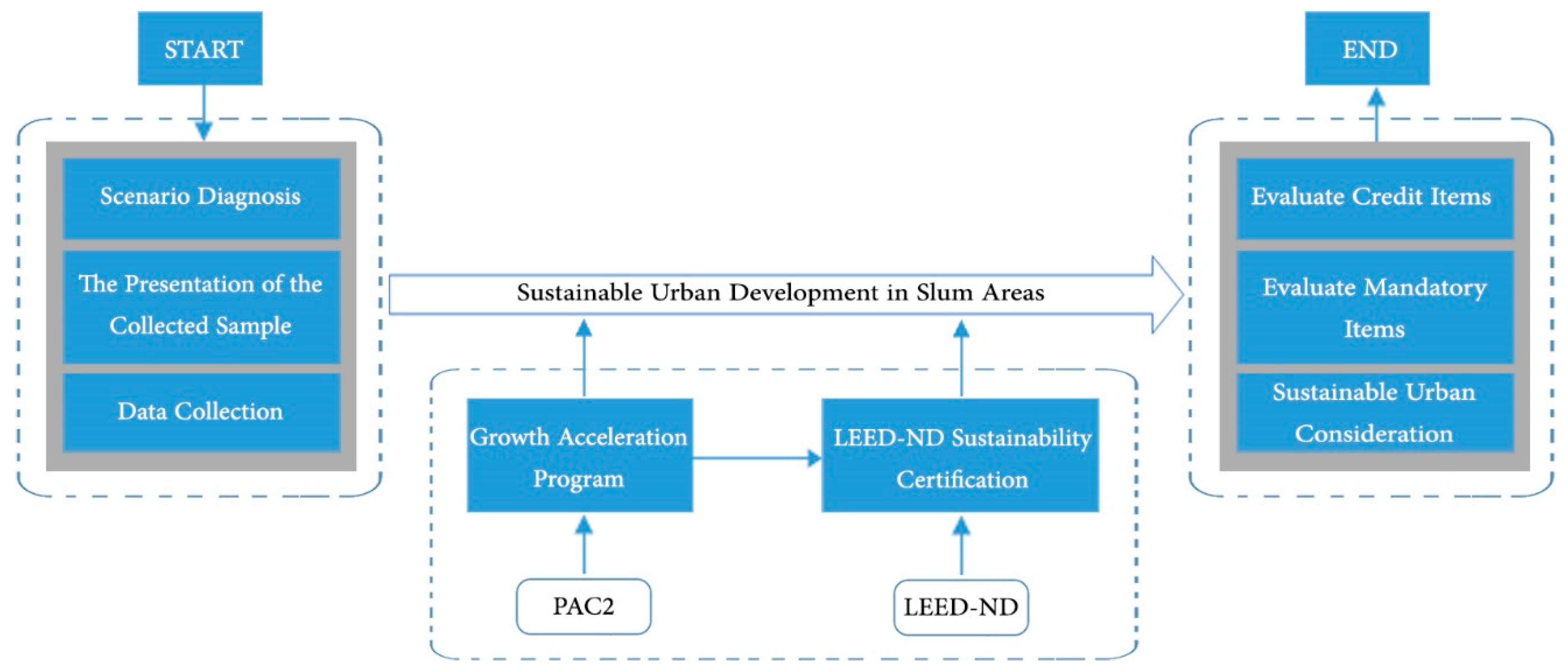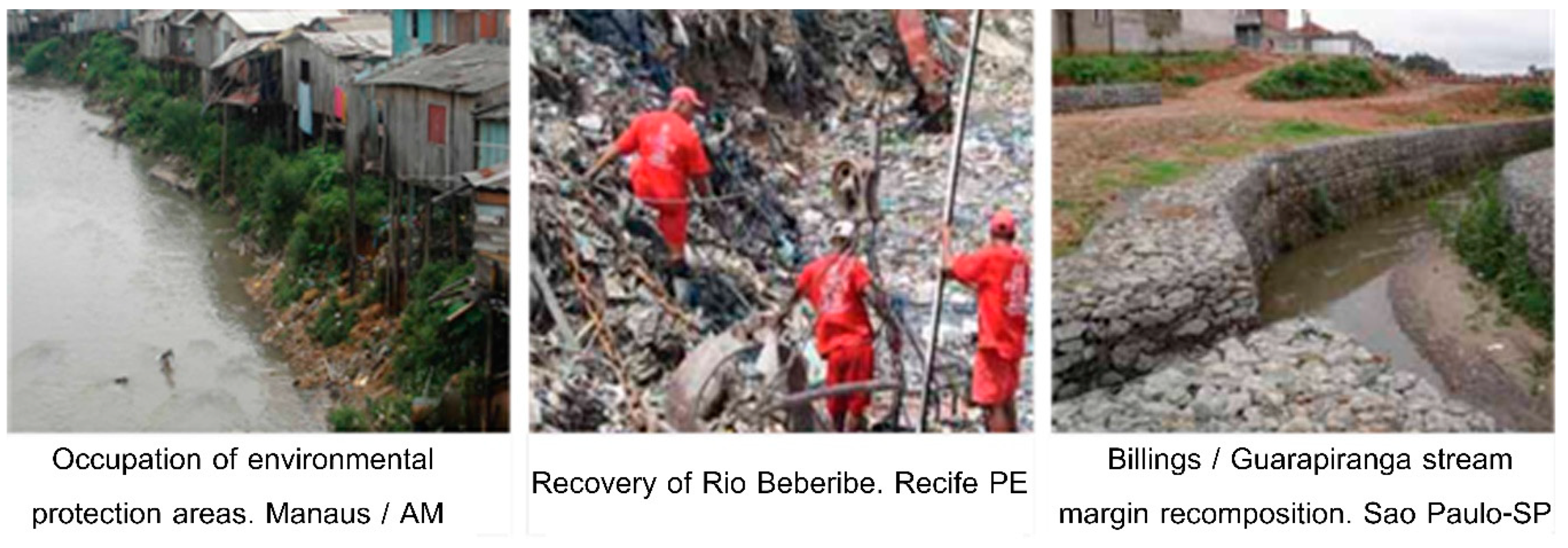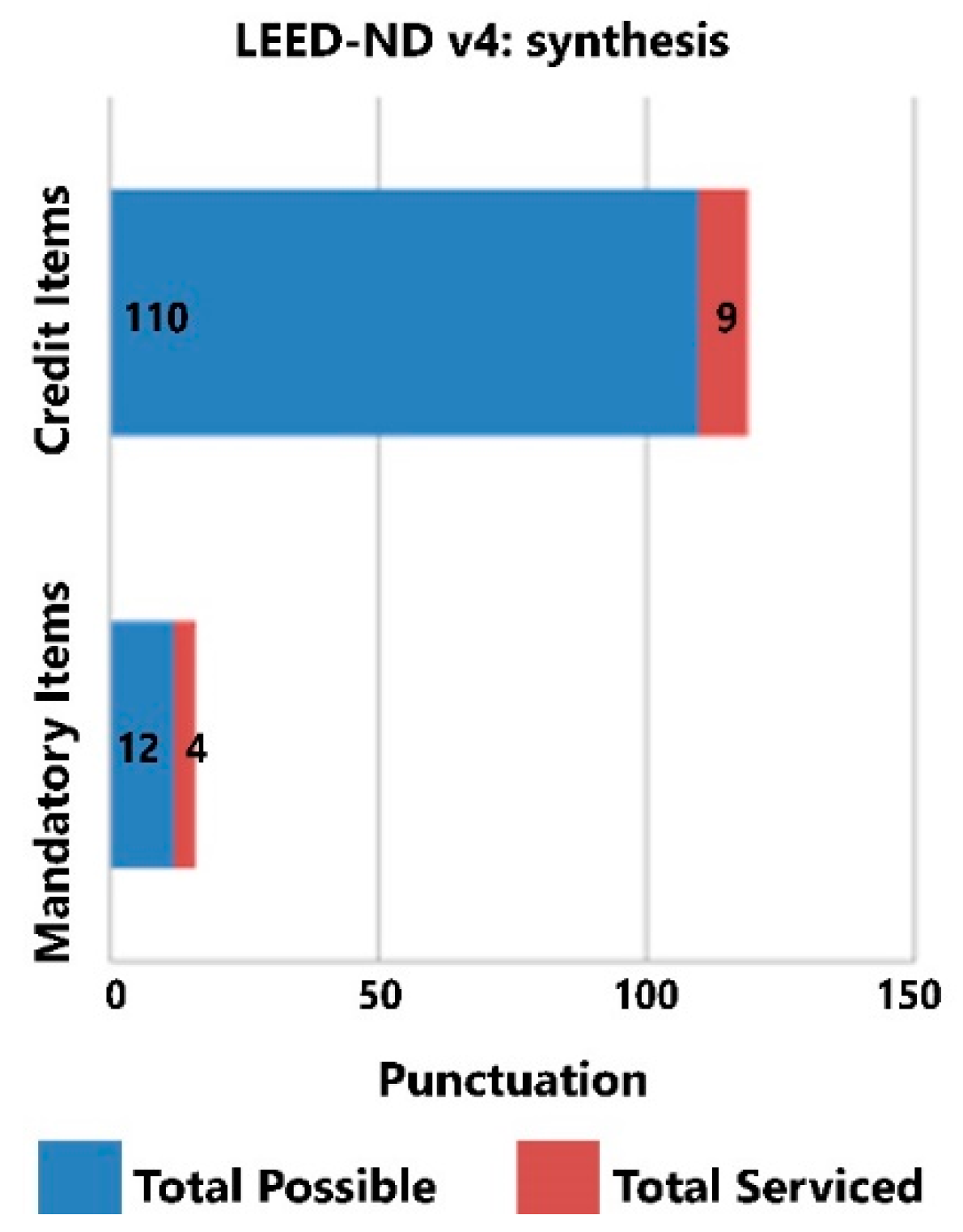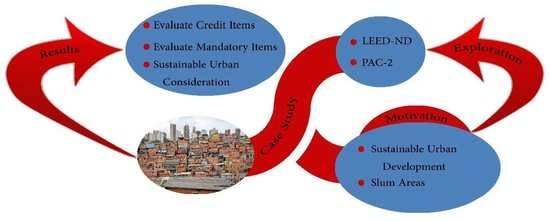Sustainable Urban Development in Slum Areas in the City of Rio de Janeiro Based on LEED-ND Indicators
Abstract
1. Introduction
Goals and Objectives
2. Materials and Methods
2.1. Scenario Diagnosis
2.2. The Presentation of the Collected Sample
2.3. Data Collection
2.4. Growth Acceleration Program
2.5. LEED-ND Sustainability Certification
3. Results
- “Smart location and bond” is a thematic group composed of five mandatory items, of which 100% have met the LEED-ND requirements.
- “Standard and neighborhood project” is a thematic group composed of three mandatory items, none of which met the LEED-ND requirements.
- “Infrastructure and green buildings” is a thematic group composed of four mandatory items, none of which met the LEED-ND requirements.
- Therefore, it can be said that the complete analysis of all checklists indicated the existence of a total of 12 mandatory items, of which only four were met, a total of 33%.
4. Conclusions
- The themes between urban development and sustainability were analyzed before the current scenario in the context of slum areas in the city of Rio de Janeiro. The correlations between a recent PAC2 project in the executive design phase (in its sub-axis “Urbanization of Slums”) were considered with the application of a system of urban sustainability indicators of national and international recognition, the LEED-ND. This sustainability indicator (LEED-ND) was selected as a specific type of LEED that deals with “Neighborhood Development”.
- During the analysis of 12 boards of the Morro do Encontro Executive Urbanism Project, a total of 11 sustainability items were divided between mandatory and credit items. Finally, after applying the weights of each credit item, the final result was concluded in nine points; as for mandatory items, these points were not fully met. Therefore, this issue demonstrates the reasons why the analyzed project could not be certified by the LEED-ND system. However, the final balance of the survey showed a total of 47 sustainability items with the potential for development to adapt to the LEED-ND sustainability criteria. The following issues were then considered; (1) the project has not yet been executed (due to the end of the Program); (2) the project has the potential to be adjusted according to the LEED-ND criteria; (3) the study scenario lacks emergency improvements to bring dignity and quality of life to its inhabitants. Therefore, it was evident that there were attempts to apply sustainable solutions to the project, however, it was insufficient. Given all the issues presented, the importance and complexity of the theme addressed are highlighted.
- These results are expected to support more inclusive development actions. Therefore, the imperative in the search for the study, development and dissemination of a more sustainable and humane mentality is reinforced. As a suggestion for future work, the analysis of these projects based on other systems of recognized sustainability indicators is indicated. In this way, it can be said that all the research objectives were met and included: the analysis of the projects of the sub-axis “Slum Urbanization” of PAC2 of the “Morro do Encontro favela”; the identification of empirical evidence of sustainability indicators in the selected projects; comparing the indicators extracted from the projects with the LEED-ND indicators.
- Despite the contemporaneity of the theme addressed and the strong presence of LEED in Brazil, the lack of material available for LEED-ND in the Portuguese language was among the difficulties faced by the research. Therefore, it can be said that given the need for adequate planning to accompany the projections of urban growth as a trend, and the need to sustain life on Earth that has existed for decades, a very complex, current, and evidently social valuable issue is faced. Additionally, it became clear that attempts at sustainable solutions have been applied in several places for years, yet unsustainable human settlements, subnormal agglomerations (such as slums) persist, reinforcing limitations on the right to the city.
Author Contributions
Funding
Acknowledgments
Conflicts of Interest
References
- Nevens, F.; Frantzeskakib, N.; Gorissen, L.; Loorbach, D. Urban Transition Labs: Co-creating transformative action for sustainable cities. J. Clean. Prod. 2013, 50, 111–122. [Google Scholar] [CrossRef]
- Ruishan, C.; Ye, C.; Cai, Y.; Xing, X.; Chen, Q. The impact of rural out-migration on land use transition in China: Past, present and trend. Land Use Policy 2014, 40, 101–110. [Google Scholar]
- Martine, G.; McGranahan, G. The legacy of inequality and negligence in Brazil’s unfinished urban transition: Lessons for other developing regions. Int. J. Urban Sustain. Dev. 2013, 5, 7–24. [Google Scholar] [CrossRef]
- Alston, M.A.; Mueller, B.; Pereira, C. Brazil in Transition: Beliefs, Leadership, and Institutional Change; Princeton University Press: Princeton, NJ, USA, 2016. [Google Scholar]
- Watson, K. Seeing from the South: Refocusing Urban Planning on the Globe’s Central Urban Issues. Urban Stud. 2009, 46, 2259–2275. [Google Scholar] [CrossRef]
- Blowers, A. The Limits of Power: The Politics of Local Planning Policy; Elsevier: Amsterdam, The Netherlands, 2017. [Google Scholar]
- Ministério das Cidades. Política Nacional de Desenvolvimento Urbano; Cadernos Mcidades Desenvolvimento Urbano; Ministério das Cidades: Brasilila, Brazil, 2004.
- Lees, L.; Shin, H.B.; Lopes-Morales, E. Global Gentrifications: Uneven Development and Displacement; Policy Press: Bristol, UK, 2015. [Google Scholar]
- Moreira, V.G.; Lourenço, R.A. Prevalence and factors associated with frailty in an older population from the city of Rio de Janeiro, Brazil: The FIBRA-RJ Study. Clinics 2013, 68, 979–985. [Google Scholar] [CrossRef]
- Olavarria-Berenguer, L. The Favelas of Rio de Janeiro: A study of socio-spatial segregation and racial discrimination. Iberoam. J. Dev. Stud. 2014, 3, 104–134. [Google Scholar] [CrossRef]
- Macke, J.; Casagrande, R.M.; Sarate, J.A.R.; Silva, A.K. Smart city and quality of life: Citizens’ perception in a Brazilian case study. J. Clean. Prod. 2018, 182, 717–726. [Google Scholar] [CrossRef]
- Dempsey, N.; Brown, C.; Bramley, G. The key to sustainable urban development in UK cities? The influence of density on social sustainability. Progress Plan. 2012, 77, 89–141. [Google Scholar] [CrossRef]
- Santos, O.A., Jr.; Novaes, P.; Lacerda, L.; Werneck, M. Políticas Públicas e Direito à Cidade: Programa Interdisciplinar de Formação de Agentes Sociais, 1st ed.; Letra Capital: Rio de Janeiro, Brazil, 2017. [Google Scholar]
- Okretic, G.A.V.W.; de Mello Bueno, L.M. Precarious Housing in Risk Areas: Perspectives within Vulnerable Communities in Brazil. In Proceedings of the Twentieth International Seminar on Urban Form, Brisbane, Australia, 17–20 July 2013. [Google Scholar]
- Rojas, E. Housing Policies, Quality of Housing and Urban Development Lessons from the Latin American Experience 1960–2010. In Proceedings of the 2015 World Bank Conference on Land and Poverty, Washington, DC, USA, 23–27 March 2015. [Google Scholar]
- Iveson, K. Cities within the City: Do-It-Yourself Urbanism and the Right to the City. Int. J. Urban Reg. Res. 2013, 37, 941–956. [Google Scholar] [CrossRef]
- Macedo, J. Planning a Sustainable City: The Making of Curitiba, Brazil. J. Plan. His. 2013, 12, 334–353. [Google Scholar] [CrossRef]
- Rodrigues, T. O Rio Que Queremos: Propostas Para uma Cidade Inclusiva; NPC Piratininga Cursos Livres e Editora Ltd.a: Rio de Janeiro, Brazil, 2016. [Google Scholar]
- República Federativa do Brasil. Il Plano Nacional de Desenvolvimento (1975–1979); República Federativa do Brasil: Brasilia, Brazil, 1974; p. 118.
- Maricato, E. Metrópoles desgovernadas. Estud. Avançados 2011, 25, 7–22. [Google Scholar] [CrossRef][Green Version]
- Brasil. [Constituição (1988)]. Constituição da República Federativa do Brasil [Recurso Eletrônico]: Texto Constitucional Promulgado em 5 de Outubro de 1988, com as Alterações Adotadas Pelas Emendas Constitucionais nos 1/1992 a 91/2016 e Pelo Decreto Legislativo no 186/2008; Senado Federal, Coordenação de Edições Técnicas: Brasilia, Brazil, 2016; Volume 1, pp. 1–242.
- Câmara dos Deputados. Agenda 21, no. 56. In Proceedings of the United Nations Conference on Environment & Development, Rio de Janeiro, Brazil, 3–4 June 1992. [Google Scholar]
- Pereira, A.D.S. Uma avaliação do Programa de Aceleração do Crescimento (PAC) no estado da Bahia (2007-10). Rev. Adm. Pública 2013, 47, 177–203. [Google Scholar] [CrossRef][Green Version]
- Casa Civil da Presidência da República. Decreto Federal No. 6025, de 22 de Janeiro de 2007; Casa Civil da Presidência da República: Brasilia, Brazil, 2007.
- Jardim, M.C.; Silva, M.R. Programa de Aceleração do Crescimento—PAC; Cultura Acadêmica: São Paulo, Brazil, 2015. [Google Scholar]
- Mc Cormick, K.; Anderbeg, S.; Coenen, L.; Neij, L. Advancing sustainable urban trasnformation. J. Clean. Prod. 2013, 50, 1–11. [Google Scholar] [CrossRef]
- Doppelt, B. Leading Change Toward Sustainability: A Change-Management Guide for Business, Government and Civil Society; Routledge: London, UK, 2017. [Google Scholar]
- Ministério das Cidades; Ministério do Meio Ambiente. Sustentabilidade Urbana: Impactos do Desenvolvimento Econômico e suas Consequências Sobre o Processo de Urbanização em Países Emergentes: Textos para as Discussões da Rio+20: Habitação Social e Sustentabilidade; Ministério do Meio Ambiente: Brasilia, Brazil, 2015; Volume 3.
- IBGE. Classificação e Caracterização dos Espaços Rurais e Urbanos do Brasil: Uma Primeira Aproximação; IBGEP: Rio de Janeiro, Brazil, 2017.
- Turcu, C. Sustainability Indicators and Certification Schemes for the Built Environment; Routledge Handbook of Sustainability Indicators: London, UK, 2018. [Google Scholar]
- Shen, L.Y.; Ochoa, J.J.; Shah, M.N.; Zhang, X. The application of urban sustainability indicators—A comparison between various practices. Habitat Int. 2011, 35, 17–29. [Google Scholar] [CrossRef]
- Yin, K.; Wang, R.; An, Q.; Yao, L.; Liang, J. Using eco-efficiency as an indicator for sustainable urban development: A case study of Chinese provincial capital cities. Ecol. Indic. 2014, 36, 665–671. [Google Scholar] [CrossRef]
- Turcu, C. Re-thinking sustainability indicators: Local perspectives of urban sustainability. J. Environ. Plan. Manag. 2013, 56, 665–719. [Google Scholar] [CrossRef]
- Hiremath, R.B.; Balachandra, P.; Kumar, B.; Bansode, S.S.; Murali, J. Indicator-based urban sustainability—A review. Energy Sustain. Dev. 2013, 17, 555–563. [Google Scholar] [CrossRef]
- Wu, P.; Mao, C.; Wang, J.; Song, Y.; Wang, X. A decade review of the credits obtained by LEED v2.2 certified green building projects. Build. Environ. 2016, 102, 167–178. [Google Scholar] [CrossRef]
- Wangel, J.; Wallhagen, M.; Malmqvist, T.; Finnveden, G. Certification systems for sustainable neighbourhoods: What do they really certify? Environ. Impact Assess. Rev. 2016, 56, 200–213. [Google Scholar] [CrossRef]
- Siqueira, A.C.H. Evidências de Sustentabilidade Urbana em Projetos de Favelas, com Base nos Indicadores LEDD-ND. Master’s Thesis, Universidade Federal do Rio de Janeiro Escola Politécnica, Rio da Janeiro, Brazil, 2018. [Google Scholar]
- USGBC. LEED, Version 4 for Neighborhood Development; US Green Building Council: Atlanta, GA, USA, 2016. [Google Scholar]
- BRASIL. Sobre o PAC. Available online: http://www.pac.gov.br/sobre-o-pac (accessed on 20 November 2016).
- BRASIL. Programa de Aceleração do Crescimento—PAC. Manual de Instruções: Projetos Prioritários de Investimentos-PPI Intervenções em Favelas. Período de 2007–2010 Brasília-DF. 2007. Available online: http://aprece.org.br/wp-content/uploads/2015/11/Manual_PAC_Favelas_2007_2010.pdf. (accessed on 29 May 2017).
- IBGE. Urbanização. In Atlas do Censo Demográfico 2010; IBGE: Rio de Janeiro, Brazil, 2010; p. 107. [Google Scholar]
- IBGE. Distribuição da população urbana. In Atlas do Censo Demográfico 2010; IBGE: Rio de Janeiro, Brazil, 2010; p. 106. [Google Scholar]
- IBGE. Censo Demográfico; IBGE: Rio de Janeiro, Brazil, 2010; pp. 89–91.
- IBGE. Crescimento da população. In Atlas do Censo Demográfico 2010; IBGE: Rio de Janeiro, Brazil, 2010; p. 22. [Google Scholar]
- GBC BRASIL. Certificado LEED: Empreendimento Registrados e Certificados. 2017. Available online: http://gbcbrasil.org.br/graficos-empreendimentos.php (accessed on 26 October 2017).
- IPP. Favela X Não favela. In Cadernos do Rio; Instituro Pereira Passos: Rio de Janeiro, Brazil, 2013; pp. 1–18. [Google Scholar]
- CONSÓRCIO. Complexo do Lins—Diagnóstico; Empresa de Obras Públicas do Estado do Rio de Janeiro/EMOP: Rio de Janeiro, Brasil, 2014.
- EMOP. Projeto Comunidade do Lins. Available online: http://www.emop.rj.gov.br/trabalho-tecnico-social/projeto-comunidade-do-lins/ (accessed on 18 November 2016).
- BRASIL. Relatório SEPAC 2016; Secretaria do Programa de Aceleração do Crescimento: Brasília, Brazil, 2016; pp. 1–33.
- Ministério das Cidades. Programa de Aceleração do Crescimento—PAC: Projetos Prioritários de Investimentos—PPI Urbanização de Assentamentos Precários—UAP. Perído de 2010–2011; Ministério das Cidades: Brasilia, Brazil, 2010.
- Cardoso, J.C., Jr.; Navarro, C.A. O Planejamento Governamental No Brasil e a Experiencia Recente (2007 a 2014) Do Programa de Aceleração Do Crescimento (PAC); Instituto de Pesquisa Econômica Aplicada: Brasilia, Brazil, 2016; pp. 1–74.
- Cryer, B.E.; Felder, J.E.; Matthews, R.E.; Pettigrew, M.I.; Okrent, B.R. Evaluating the Diffusion of Green Building Practices; Applied Management Research Project; UCLA Anderson School of Management: Los Angeles, CA, USA, 2006; p. 78. [Google Scholar]
- Petinelli. O Desenvolvimento das Construções Sustentáveis no Sul do Brasil—GBC Brasil. Available online: http://blog.gbcbrasil.org.br/?p=3020 (accessed on 26 October 2017).
- Matthiessen, L.F.; Morris, P. Cost of Green Revisited: Reexamining the Feasibility and Cost Impact of Sustainable Design in the Light of Increased Market. Adoption; Continental Automated Buildings Association: Austin, TX, USA, 2007; pp. 1–25. [Google Scholar]
- Gil, J.; Duarte, J.P. Tools for evaluating the sustainability of urban design: A review. In Proceedings of the Institution of Civil Engineers—Urban Design and Planning; ICE Publishing: London, UK, 2013; Volume 166, pp. 311–325. [Google Scholar]
- GBC Brasil. “Revista GBC Brasil 2015: Certificações”; Green Building Council: Vibeditora São Paulo, Brazil, 2015; Volume 4, pp. 1–150.
- GBC Brasil. “Revista GBC Brasil 2016: Construindo um Futuro Sustentável”; Green Building Council: Vibeditora, São Paulo, Brazil, 2016; Volume 9, pp. 1–232.






| Year | Name of the Event and/or Document | Source |
|---|---|---|
| 1953 | Federal agency “Housing and Urbanism” | [17] |
| The decade of the 1960s | National Housing Bank | [18] |
| 1975 | Second National Development Plan (II NDP-1975/79) | [19] |
| The decade of the 1980s | Relevance for discussions about “marginality” (started in the 1960s and 1980s) with prominence in the national political scene | [17] |
| 1985 | Ministry of Urban Development and Environment | [20] |
| 1988 | Brazilian Federal Constitution (CF/88), which instituted the Master Plan and the Right to the Environment | [21] |
| 1990 | Ministry of Social Action | [20] |
| 1992 | Production of important documents, such as Rio Declaration on Environment and Development Declaration of Principles on the Use of Forests United Nations Convention on Biological Diversity United Nations Convention on Climate Change Global Agenda 21 | [20] |
| 1992 | Rio-ECO92 | [22] |
| 2001 | City Statute | [23] |
| 2003 | Principles and guidelines of Brazilian urban policy 1st National Conference of Cities | [20] |
| 2003 | Ministry of Cities | [20] |
| 2006 | National Urban Development Policy (NUDP) | [20] |
| 2007–2010 | 1st phase of the Growth Acceleration Program (PAC) | [24] |
| 2009 | Programa Minha Casa Minha Vida (My House My Life Program) (PMCMV)—PHASE 1 | [18] |
| 2011–2014 | 2nd phase of the Growth Acceleration Program (PAC2)/ Programa Minha Casa Minha Vida (My House My Life Program) (PMCMV)—PHASE 2 | [25] |
| Evidence of Sustainability Extracted from the Project | |
|---|---|
| 1 | Water infrastructure |
| 2 | Sewage infrastructure |
| 3 | Reforestation (Georio) |
| 4 | Reforestation (PAC) |
| 5 | Eco-limit |
| 6 | Community garden |
| 7 | Open spaces (Urban Oxygenators) |
| 8 | Habitat Conservation |
| 9 | Containment walls (Georio) |
| 10 | Containment walls (PAC) |
| 11 | Previously occupied location |
| 12 | Location in need of development |
| 13 | Pre-existing connectivity |
| 14 | Government program |
| 15 | Bus bays within the proposed limits |
| 16 | Staircase recovery |
| 17 | Removing homes in risk areas |
| 18 | New road with sidewalks |
| 19 | Recovery of sports areas |
| 20 | Restoration of leisure areas |
| 21 | Main access revitalization |
| 22 | Participatory research methodology |
| 23 | Research on secondary bases |
| 24 | Preservation of vegetation |
| 25 | Steep slope protection |
| 26 | Sediment control |
| Thematic Contexts of Neighborhood Sustainability by LEED-ND | ||
|---|---|---|
| Mandatory Items | Credit Items | |
| Smart location and nexus | 5 | 28 |
| Neighborhood pattern and design | 3 | 41 |
| Green buildings and infrastructure | 4 | 31 |
| Innovation and design process | 0 | 6 |
| Regional priority credits | 0 | 4 |
| Total | 12 | 110 |
| Mandatory Items LEED-ND | |||||||||||||||||
|---|---|---|---|---|---|---|---|---|---|---|---|---|---|---|---|---|---|
| Evidence of sustainability | 1 | 2 | 3 | 4 | 5 | 6 | 7 | 8 | 9 | 10 | 13 | 16 | 18 | 19 | 20 | 24 | 26 |
| Smart location and nexus | |||||||||||||||||
| Smart location | x | x | x | x | |||||||||||||
| At-risk species and ecological communities | x | x | x | ||||||||||||||
| Conservation of floodplain and water bodies | x | ||||||||||||||||
| Conservation of arable land | x | ||||||||||||||||
| Flood quota spacing | x | x | x | x | x | x | x | x | x | ||||||||
| Neighborhood pattern and design | |||||||||||||||||
| Walkable streets | x | ||||||||||||||||
| Compact development | |||||||||||||||||
| Connected and open community | |||||||||||||||||
| Green buildings and infrastructure | |||||||||||||||||
| Certified buildings | |||||||||||||||||
| Minimum energy efficiency in buildings | |||||||||||||||||
| Minimum water efficiency in buildings | |||||||||||||||||
| Pollution prevention in construction activity | x | ||||||||||||||||
| Empirical Evidence of Sustainability Implicit in the Project | |||||||||||||||||
|---|---|---|---|---|---|---|---|---|---|---|---|---|---|---|---|---|---|
| Evidence of sustainability | 2 | 3 | 4 | 5 | 8 | 9 | 10 | 11 | 12 | 13 | 14 | 15 | 17 | 21 | 22 | 23 | 25 |
| Smart location and nexus | |||||||||||||||||
| Preferred location | x | x | x | ||||||||||||||
| Re-urbanization of contaminated areas | x | ||||||||||||||||
| Quality access and transport | x | ||||||||||||||||
| Steep slope protection | x | x | x | x | x | ||||||||||||
| A project of land for the conservation of habitat or wetlands and bodies of water | x | x | x | ||||||||||||||
| Other credit items | |||||||||||||||||
| Neighborhood pattern and design | |||||||||||||||||
| Access to civic and public spaces | x | ||||||||||||||||
| Community outreach and involvement | x | x | |||||||||||||||
| Other credit items | |||||||||||||||||
| Green buildings and infrastructure | |||||||||||||||||
| Reduce terrain disturbance | x | ||||||||||||||||
| Other credit items | |||||||||||||||||
| Innovation and design process | |||||||||||||||||
| Minimum water efficiency in buildings | |||||||||||||||||
| Pollution prevention in construction activity | |||||||||||||||||
| Regional priority credits | |||||||||||||||||
| Regional Credit | |||||||||||||||||
| Thematic Context LEED-ND | N° of Mandatory Items | N° of Credit and Score Items | Did You Attend the Thematic Context? |
|---|---|---|---|
| Smart location and nexus | MI = 05 IA = 04 | CI = 28 points IA = 05/09 LS = 07 points | Yes |
| Neighborhood pattern and design | MI = 03 IA = 0 | CI = 41 points IA = 01/15 LS = 01 points | No |
| Green buildings and infrastructure | MI = 04 IA = 0 | CI = 31 points IA = 01/17 LS = 01 points | No |
| Innovation and design process | MI = 0 IA = 0 | CI = 06 points IA = 00/02 LS = 00 points | No |
| Regional priority credits | MI = 0 IA = 0 | CI = 04 points IA = 00/04 LS = 00 points | No |
| Total | MI =12 IA = 04 | CI = 110 points IA = 07 LS = 09 points | No |
| Smart Location and Links |
| Credit items (04/09): |
|
| Neighborhood Pattern and Design |
| Mandatory items (03/03): |
|
| Credit items (14/15): |
|
| Green Buildings and Infrastructure |
| Mandatory items (04/04): |
|
| Credit items (16/17): |
|
| Innovation and Design Process |
| Credit items (02/02): |
|
| Regional Priority Credits |
| Credit items (04/04): |
|
© 2020 by the authors. Licensee MDPI, Basel, Switzerland. This article is an open access article distributed under the terms and conditions of the Creative Commons Attribution (CC BY) license (http://creativecommons.org/licenses/by/4.0/).
Share and Cite
de Siqueira, A.C.H.; Najjar, M.K.; Hammad, A.W.A.; Haddad, A.; Vazquez, E. Sustainable Urban Development in Slum Areas in the City of Rio de Janeiro Based on LEED-ND Indicators. Buildings 2020, 10, 116. https://doi.org/10.3390/buildings10070116
de Siqueira ACH, Najjar MK, Hammad AWA, Haddad A, Vazquez E. Sustainable Urban Development in Slum Areas in the City of Rio de Janeiro Based on LEED-ND Indicators. Buildings. 2020; 10(7):116. https://doi.org/10.3390/buildings10070116
Chicago/Turabian Stylede Siqueira, Ana Carolina Hyczy, Mohammad K. Najjar, Ahmed W. A. Hammad, Assed Haddad, and Elaine Vazquez. 2020. "Sustainable Urban Development in Slum Areas in the City of Rio de Janeiro Based on LEED-ND Indicators" Buildings 10, no. 7: 116. https://doi.org/10.3390/buildings10070116
APA Stylede Siqueira, A. C. H., Najjar, M. K., Hammad, A. W. A., Haddad, A., & Vazquez, E. (2020). Sustainable Urban Development in Slum Areas in the City of Rio de Janeiro Based on LEED-ND Indicators. Buildings, 10(7), 116. https://doi.org/10.3390/buildings10070116










